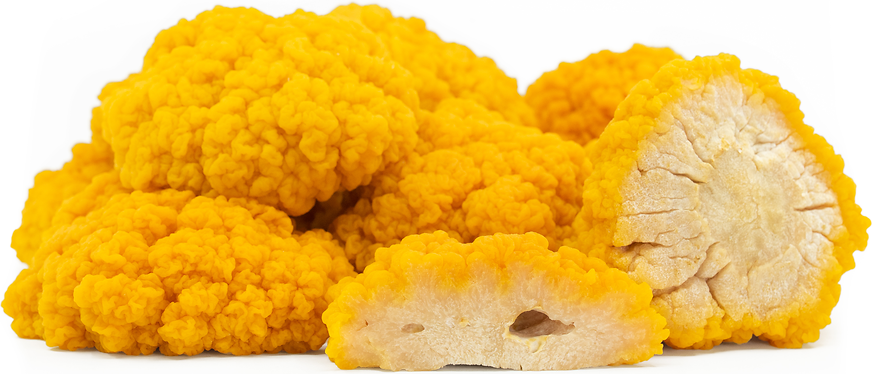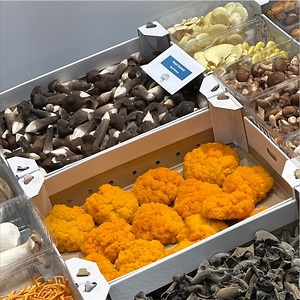


Golden Ear Mushrooms
Estimated Inventory, 5 lbs : 0
Description/Taste
Golden Ear mushrooms are small to medium in size, averaging 5-10 centimeters in diameter, and are stemless composed of clusters of many wrinkled, folded lobes. When fresh, the bright orange to yellow flesh appears wet and has a gelatinous to an opaque appearance with a white, milky center. When dried, the flesh becomes shriveled and takes on a golden matte finish becoming brittle and similar in appearance to an orange cauliflower. When cooked, Golden Ear mushrooms are slightly rubbery with a mild, neutral flavor.
Seasons/Availability
Golden Ear mushrooms are available year-round, with a peak season in the fall.
Current Facts
Golden Ear mushrooms are a variety of jelly fungi that are often classified as two identified species, Tremella aurantia, and Tremella mesenterica, as they can only be distinguished microscopically and the names are used interchangeably. Golden Ear mushrooms are among a few varieties that have a symbiotic relationship with another fungus. Just like lobster mushrooms, they can be found growing on or completely enveloping varieties such as curtain crust mushrooms, Stereum hirsutum, and some Peniophora species. Once Golden Ear mushrooms become fully developed, they will completely consume the host mushroom leaving no evidence of it behind. Also known as Witch's Butter, Yellow Ear, and Yellow Brain fungus, Golden Ear mushrooms can be found growing on fallen dead or decaying trunks of conifer or hardwood trees and are foraged for in the wild due to their specific growing habits and inability to be cultivated on a large scale. Golden Ear mushrooms are mainly consumed in Asia, especially in China, and are exported from China to the rest of the world for use in soups and stews.
Nutritional Value
Golden Ear mushrooms are a good source of potassium, iron, and calcium. They are also a source of trace elements such as manganese, a beneficial antioxidant that has a role in the production of collagen to help prevent and repair wrinkles.
Applications
Golden Ear mushrooms must be cooked before consumption and are best suited for applications such as boiling and sautéing. They are commonly added to soups, curries, and stews for color, texture, and added nutrition. They can also be sautéed along with other mushrooms, leafy greens, and onions, and served as a vegetable side dish, mixed in stir-fries with meat for a main dish, or dried for extended use. Once dried, the mushrooms can easily be moistened with water or a soup base and are used in a variety of quick-cooking dishes. Golden Ear mushrooms pair well with garlic, ginger, green onions, thyme, cilantro, coriander, carrots, peppers, tofu, pork belly, poultry, fish, sesame oil, soy sauce, and vinegar. They will keep up to a week when stored loosely in a paper bag in the refrigerator. Dried Golden Ear mushrooms will store for up to three months in an airtight container.
Ethnic/Cultural Info
Golden Ear mushrooms are one of eight hundred and fifty varieties of fungus that can be found in the rich climate of China’s southwestern Yunnan province. In this province, Golden Ear mushrooms have been used for culinary and medicinal purposes for centuries. In traditional Chinese medicine, the Golden Ear mushroom is used to increase metabolism, detoxify, promote healthy liver function, and help lower cholesterol. In Europe, the jelly-like fungus earned the name “Witch’s butter” for its unusual color and appearance. Ancient folklore says that if the Witch’s Butter fungus appears at a gate or front door, a witch has put a spell on a member of the family. The mushroom must be pierced to remove the curse.
Geography/History
Golden Ear mushrooms are native to China’s Yunnan province in the southwestern part of the country that lies just north of Myanmar and Laos. Predominantly found along the Jinsha River Basin, Golden Ear mushrooms are still largely consumed in Yunnan and can also be found at farmers markets and specialty grocers throughout North America and in western Europe from Norway to Portugal.
Recipe Ideas
Recipes that include Golden Ear Mushrooms. One
| The Singapore Women's Weekly |
|
Fish Maw And Wild Yellow Gold Ear Mushroom Soup |
Podcast









